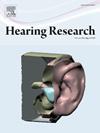Sound degradation type differentially affects neural indicators of cognitive workload and speech tracking
IF 2.5
2区 医学
Q1 AUDIOLOGY & SPEECH-LANGUAGE PATHOLOGY
引用次数: 0
Abstract
Hearing-in-noise (HIN) is a challenging task that is essential to human functioning in social, vocational, and educational contexts. Successful speech perception in noisy settings is thought to rely in part on the brain's ability to enhance neural representations of attended speech. In everyday HIN situations, important features of speech (i.e., pitch, rhythm) may be degraded in addition to being embedded in noise. The impact of these differences in sound quality on experiences of workload and neural representations of speech will be important for informing our knowledge on the cognitive demands imposed by every-day difficult listening situations. We investigated HIN perception in 20 healthy adults using continuous speech that was either clean, spectrally degraded, or temporally degraded. Each sound condition was presented both with and without pink noise. Participants engaged in a selective listening task, in which a short-story was presented with varying sound quality, while EEG data were recorded. Neural correlates of cognitive workload were obtained using power levels of two frequency bands sensitive to task difficulty manipulations: alpha (8 – 12 Hz) and theta (4 – 8 Hz). Acoustic and linguistic features (speech envelope, word onsets, word surprisal) were decoded to reveal the degree to which speech was successfully encoded. Overall, alpha-theta power increased significantly when noise was added across sound conditions, while prediction accuracy of speech tracking decreased, suggesting that more effort was required to listen, and that the speech was not as successfully encoded. The temporal degradation also resulted in greater EEG power, possibly as a function of a compensatory mechanism to restore the important temporal information required for speech comprehension. Our findings suggest that measures related to cognitive workload and successful speech encoding are differentially affected by noise and sound degradations, which may help to inform future interventions that aim to mitigate these every-day challenges.
声音退化类型对认知负荷和语音跟踪神经指标的影响存在差异
噪声听力(HIN)是一项具有挑战性的任务,对人类在社会、职业和教育环境中的功能至关重要。在嘈杂的环境中,成功的语言感知被认为部分依赖于大脑增强参与演讲的神经表征的能力。在日常的HIN情况下,语音的重要特征(即音调、节奏)除了嵌入噪声中之外,还可能会降级。这些音质差异对工作负荷体验和语音神经表征的影响将对我们了解日常困难听力情况所施加的认知需求具有重要意义。我们调查了20名健康成人的HIN感知,他们使用连续的语言,无论是干净的,频谱退化的,还是暂时退化的。每种声音条件都有粉红噪声和无粉红噪声。参与者参与了一项选择性听音任务,在这个任务中,一篇短篇故事以不同的声音质量呈现,同时记录下脑电图数据。通过对任务难度操作敏感的两个频段:α (8 - 12 Hz)和θ (4 - 8 Hz)的功率水平,获得认知工作量的神经相关性。声学和语言特征(语音包络,单词开始,单词惊讶)被解码,以揭示语音成功编码的程度。总的来说,当在不同的声音条件下加入噪音时,α - θ能量显著增加,而语音跟踪的预测准确性下降,这表明需要更多的努力来倾听,并且语音没有成功编码。时间退化也导致脑电图功率增大,这可能是一种补偿机制的功能,用于恢复语音理解所需的重要时间信息。我们的研究结果表明,与认知负荷和成功的语音编码相关的措施受到噪音和声音退化的不同影响,这可能有助于为未来的干预措施提供信息,旨在减轻这些日常挑战。
本文章由计算机程序翻译,如有差异,请以英文原文为准。
求助全文
约1分钟内获得全文
求助全文
来源期刊

Hearing Research
医学-耳鼻喉科学
CiteScore
5.30
自引率
14.30%
发文量
163
审稿时长
75 days
期刊介绍:
The aim of the journal is to provide a forum for papers concerned with basic peripheral and central auditory mechanisms. Emphasis is on experimental and clinical studies, but theoretical and methodological papers will also be considered. The journal publishes original research papers, review and mini- review articles, rapid communications, method/protocol and perspective articles.
Papers submitted should deal with auditory anatomy, physiology, psychophysics, imaging, modeling and behavioural studies in animals and humans, as well as hearing aids and cochlear implants. Papers dealing with the vestibular system are also considered for publication. Papers on comparative aspects of hearing and on effects of drugs and environmental contaminants on hearing function will also be considered. Clinical papers will be accepted when they contribute to the understanding of normal and pathological hearing functions.
 求助内容:
求助内容: 应助结果提醒方式:
应助结果提醒方式:


